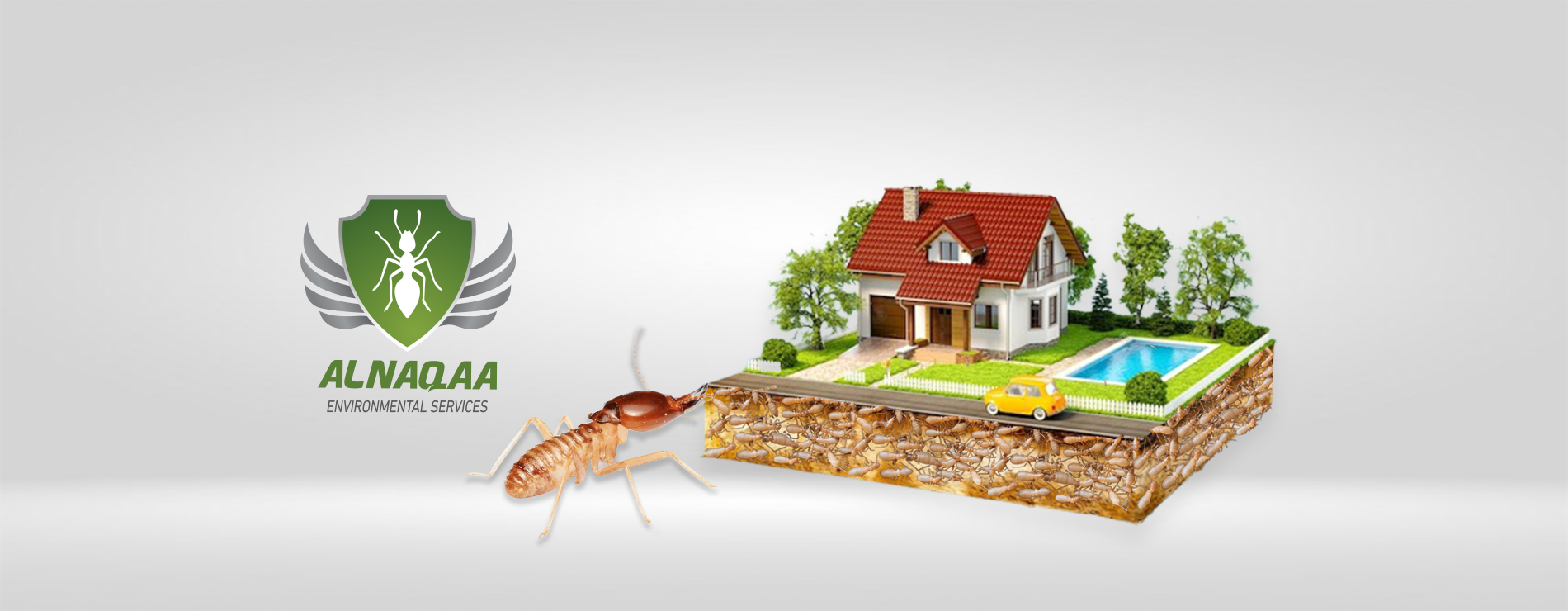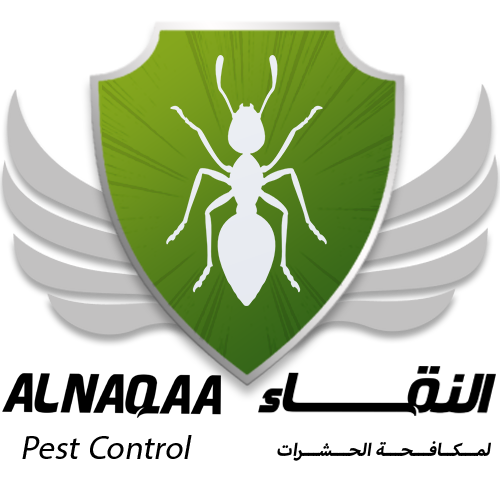
How To Get Rid of Termites OR Termite Extermination
Termite risk and damage
Repairs can be complicated and expensive depending on the location and degree of the damage, as well as the building materials necessary to repair it. As a result, identifying the infestation early is critical. Termites can cause damage to the following structural components in a home: floors, support beams, posts, wall studs, floor joists, ceiling joists, roof supports, plasterboard or sheetrock, attics and foundations. Although structural failure due to termite damage is not prevalent, it can be readily avoided by using regular inspections and insect pest control treatments supplied by Alnaqaa Company Termite inspectors will offer two-part reports outlining existing damage as well as anticipated causes and areas of future damage. Damp spaces, woodpiles, and unsecured timber panelling are all high-risk regions for infestation. Addressing these issues may help to prevent termite infestations and save homeowners money on structure repairs.
Detecting Termite Infestation
Because termite activity may not be visible for months or even years, it is critical to have your property evaluated by a skilled professional from Al-Naqaa Environmental Services Company’s engineers and specialists. The absence of swarms of these winged insects does not mean that your home is safe from them. While an abundance of termites flying around your windows or foundation is a telling sign of an active infestation, there are a few other warning signs that can suggest a problem.
If you suspect termite activity on your property, contact a termite identification expert as soon as possible. Pest control in Alnaqaa Professionals are qualified to treat any current termite indicators in a home as well as develop measures to assist avoid future problems. Alnaqaa anti-termite can help secure your house with a termite treatment plan tailored to your unique needs by using a specialized approach to termite management. Don’t let termites consume your house! Contact your local Alnaqaa Environmental Services branch to learn more about termite prevention.

Installing a liquid termiticide pretreatment is a two-step process that entails creating a horizontal barrier of treated soil beneath the building and a vertical barrier of treated soil around the external building foundation.
Step 1: Install the horizontal barrier before pouring the building’s slab or foundation, but after all form boards and other preparation for pouring the slab or foundation has been finished.
Step 2: The vertical barrier, also known as the exterior perimeter treatment, is installed immediately after the building is finished and the final exterior perimeter grade is determined.
Post-construction treatments are done to older, established structures. Because termiticide treatments do not last forever, structures must be re-treated for termites on a regular basis to maintain pest protection, and a building that is several decades old may have received several termite treatments. Post-construction treatments can be used both preventively and remedially. Even in the absence of current termite infestations, preventive treatments may be necessary due to the length of time since the last termite treatment or in reaction to an issue that has undermined the treatment.
Termites: How Do You Get Rid of Them?
Termite-killing solutions applied to the exterior of your home, direct chemicals used on the inside of your home, termite baits installed, and boric acid sprayed in your floors and walls are some of the finest ways to get rid of termites. If you’re determined to take on a termite infestation on your own, there are numerous solutions available to you, ranging from classic chemical killers to organic alternatives.
Before delving into alternative termite control strategies, it is vital to understand that termite treatments are divided into two categories based on when they are applied: preconstruction treatments and postconstruction treatments.
Preconstruction treatments are protective treatments that are applied or installed during the construction of a building and immediately after it is completed. Obviously, preconstruction treatments can only be used once during a building’s existence. Some treatments and physical barriers can only be used at this stage, however, there are other termite treatment methods that can be used either as preconstruction or postconstruction treatments. Any later expansions to a building must likewise be appropriately pretreated.

Methods of termite control.
- Termiticide treatments in liquid The most frequent method of termite control is liquid termiticide. Liquid termiticides are insecticides designed specifically for termite control. These compounds are diluted in water and put to the soil directly beneath or around a building’s foundation to create a zone of treated soil that prevents termites from tunnelling through it. This exploits underground termites’ feeding behaviour as well as their natural urge to return to the soil for moisture. Aside from termiticide safety and efficacy, one of the most significant requirements for a good termiticide is the period of residual control the product will provide. Some of the better soil-applied termiticides will keep termites at bay for 8 to 12 years or more. Fipronil, imidacloprid, chlorantraniliprole, permethrin, cypermethrin, and bifenthrin are among the active chemicals of liquid termiticides. Liquid termiticides are commonly used to control termites both before and after construction.
- Termiticide treatments in the form of foam. Foam termiticide treatments are insecticides that have been diluted in water with a particular foaming agent to create an end-use product with the consistency of shaving cream. Foam treatments are typically used to augment the control offered by other types of termite treatments. They can be injected into wall voids and other spaces in structures and foundations, where their consistency allows them to spread laterally and even upward to reach locations that a liquid termiticide would not be able to reach. The foam degrades fast, leaving the pesticide residue on the treated void’s interior surfaces. Many insecticides that are used as liquid termiticides can also be combined and utilised as foam termiticide treatments. Foam termiticides are available in premixed aerosol cans and can be mixed and administered using specific foam applicator tanks. Foam termiticide treatments are particularly effective at controlling aerial colonies of Formosan termites. Fipronil and imidacloprid are the most often utilised active components in foam termiticide treatments.
- Treatments with borates. Borate treatments are preconstruction treatments that are diluted with water and applied to the bottom two feet of studs, sill plates, exposed inner surfaces of outer sheathing, and other framing elements in contact with the concrete slab. The treatment must be applied only after the building has been “dried in” or “blacked in,” and before insulation and internal wall coverings have been put. Currently, the only active ingredient permitted for use as a termite preconstruction borate treatment is disodium octaborate tetrahydrate. Buildings treated with a preconstruction borate treatment must also be treated with an approved liquid termiticide on the outer perimeter. Essentially, the borate treatment substitutes the horizontal barrier portion of the sub-slab/sub-foundation of a preconstruction treatment.
- Preservatives for wood/”treated wood.” It should be noted that this kind of treatment is better suited for usage in outdoor, extra-building construction rather than in residences and other structures. To defend against termites and wood decay fungi, wood elements such as posts and landscaping timbers that will come into direct contact with the ground must be chemically treated. Treated wood is utilised in the construction of fences, decks, external steps and other outdoor/extra-building structures, however most building rules forbid direct wood to earth contact within buildings. One reason for this is that, even with pressure-treated wood, treatments may not always reach the treated timber’s centre, and an in-ground post with an unprotected centre gives termites with easy access.
- Baiting stations for termites. To control termites, termite baiting stations use low dosages of specifically selected, slow-acting, non-repellent pesticides that are impregnated into wood or another attractive substrate. There are two types of baiting stations: in-ground and aboveground, however in-ground baiting stations are the most prevalent. In-ground baiting stations are set in the ground at regular intervals around the building’s perimeter. Foraging termite workers find the baiting stations, dine on the poisoned bait, and share it with the rest of the colony, including the immature and reproductive stages. Bait treatments are slow-acting, but they eventually destroy the colony. In-ground baiting stations are an efficient long-term termite protection solution when properly constructed and maintained. There are several brands of termite baiting stations available. Most stations are first baited with a piece of wood or other substrate that is appealing to termites but does not contain pesticide. These stations are monitored on a regular basis, and if termite feeding is identified, the old bait is changed with a new bait containing pesticide, and the termites are permitted to continue feeding. Some brands of baiting stations, on the other hand, incorporate the active substance in the original bait. The following active substances are currently utilised in baiting stations: noviflumuron, hexaflumuron, novaluron, diflubenzuron, hydramethylnon, and sulfluramid.

The Last Words
Termites are one of the most damaging pests in the world, destroying entire homes in some areas. If you don’t keep them under control, they’ll swiftly spread to other parts of your house and inflict extensive damage. Remember to keep all of these factors in mind to avoid a termite infestation on your property! Contact Alnaqaa Environmental Services for additional information and helpful hints.




